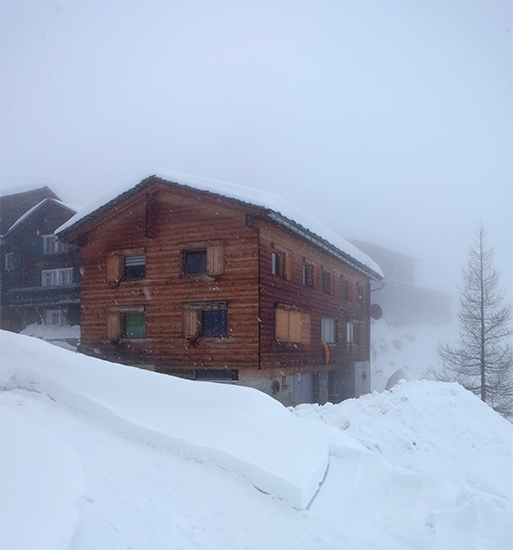 |
 |
 |
 |


Twin House Casanova
Dado Baselgia 39, Vrin
1998
Like most houses designed by Gion A. Caminada, the semi-detached Casa Casanova is realized as a block construction. This construction method with walls of stacked solid wooden beams is particularly common in the Alpine region and has a long tradition there. Nevertheless, block construction has been used less and less frequently in recent years. This kind of construction is considered uneconomical due to the high wood consumption. Size limitations due to inherent dimensions and severe deformations due to shrinkage are generally considered to be disadvantages of this construction method. Gion A. Caminada has proven with his buildings that the restrictions on residential buildings are not decisive, and that economically viable buildings can be realized. It has proven to be a great advantage that the local resources can be used for these buildings. Through his patient examination of this construction method, he succeeded in further developing the characteristic construction method with the strict logic through various innovations. In contrast to the usual two-sided overlapping at the corners, the twin house Casanova features only one-sided projections of the transverse walls. Towards the neighboring houses, an L-shaped wall made of exposed concrete runs from the ground up to the roof. This wall features the entrance door with a small canopy and irregularly arranged windows. This wall grows out of the concrete basement. On the opposite side towards the valley, the basement floor is visible in its entire height due to the topography, and allows access from the outside. The two-storey timber construction was erected above this basement. Ridge and eaves of the gable roof are aligned parallel to the slope. The main façade shows three large, horizontal windows on the ground floor, which are unusual for a block construction. On the floor above, five windows of equal size are arranged at irregular intervals. The wooden beams over the windows are slightly protruding in the context of the shutters.
In his early residential buildings, Gion A. Caminada refers to the traditional three-room house, in which a corridor serves as a common vestibule between the kitchen and the living room. The semi-detached Casa Casanova from 1998 also refers to this typology. However, in this case, the space between them is the zone of a common circulation for the two apartments. From here a common staircase leads to the basement. There is an individual staircase in both apartments for access to the rooms on the upper floor. The apartments themselves are based on a three-room typology. In both apartments there is a centrally located stove made of stone. This stove acts as the heart of the apartments and serves to heat all the main rooms. The conventional layout of the apartments is transformed by the arrangement of the stove.
Wie die meisten Wohnhäuser von Gion A. Caminada ist auch das Doppelhaus Casanova als Strickbau konstruiert. Diese Blockbauweise mit Wänden aus aufeinander geschichteten massivem Holzbalken ist insbesondere im Alpenraum verbreitet und hat dort eine lange Tradition. Dennoch wurde die Strickbauweise in den vergangenen Jahren immer seltener angewendet. Die Bauweise gilt als unwirtschaftlich aufgrund des hohen Holzverbrauchs. Grössenbeschränkungen aufgrund der naturgegebenen Dimensionen und die starken Verformungen durch das Schwinden werden im Allgemeinen als Nachteile dieser Konstruktion betrachtet. Gion A. Caminada hat mit seinen Bauten nachgewiesen, dass die Einschränkungen für Wohnbauten nicht massgebend sind, und dass sich ökonomisch vertretbare Bauten realisieren lassen. Als grosser Vorteil hat sich dabei erwiesen, dass für diese Bauten die örtlichen Resourcen genutzt werden können. Durch seiner geduldige Auseinandersetzung mit dieser Bauweise ist es ihm gelungen, die charakteristische Bauweise mit der strengen Logik durch verschiedene Neuerungen weiter zu entwickeln. Im Gegensatz zur üblichen, beidseitigen Überblattung an den Ecken weist das Doppelhaus Casanova nur einen einseitigen Überstand der Querwände auf. sZum Dorf hin verläuft zudem eine Winkelförmige Sichtbetonwand bis unter das Dach. Diese Wand nimmt die Eingangstüre mit einem kleinen Vordach sowie unregelmässig angeordnete Fenster auf. Diese Wand wächst aus dem betonierten Untergeschoss hervor. Auf der gegenüberliegenden Seite zum Tal tritt das Untergeschoss aufgrund der Topographie in seiner ganzen Höhe hevor, und ermöglicht den Zugang von Aussen. Über diesem Untergeschoss wurde der zweigeschossige Holzbau errichtet. Das Satteldach wurde mit First und Traufe parallel zum Hang ausgerichtet. Die Hauptfassade zum Tal zeigt im Erdgeschoss drei grosse, horizontale Fenster, welche für einen Strickbau ungewöhnlich sind. Im Geschoss darüber sind fünf gleich grosse Fenster in unregelmässigen Abständen angeordnet. Die Holzbalken über den Fenstern sind im Zusammenhang mit den Fensterläden leicht vorstehend.
Bei seinen frühen Wohnbauten bezieht sich Gion A. Caminada auf das traditionelle Dreiraumhaus, bei welchem ein Korridor als gemeinsamer Vorraum zwischen Küche und Stube dient. Das Doppelhaus Casanova aus dem Jahre 1998 bezieht sich ebenfalls auf diese Typologie. Allerdings ist der dazwischen liegende Raum in diesem Fall die Zone der gemeinsamen Erschliessung der beiden Wohnungen. Von hier führt eine gemeinsame Treppe ins Untergeschoss. Für den Zugang zu den Räumen im oberen Geschosse gibt es eine individuelle Treppe in beiden Wohnungen. Die Wohnungen selbst basieren wiederum auf einer Dreiraum-Typologie. In beiden Wohnungen gibt es einen zentral angeordneten Speckstein-Ofen. Dieser wirkt als Herz der Wohnungen und dient zur Beheizung aller Haupträume. Durch die Anordnung des Ofens wird die herkömmliche Raumaufteilung transformiert.